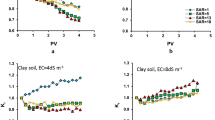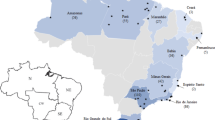Abstract
Modeling unsaturated water flow in soil requires knowledge of the hydraulic properties of soil. However, correlation between soil hydraulic properties such as the relationship between saturated soil-water content θ s and saturated soil hydraulic conductivity k s as function of soil depth is in stochastic pattern. On the other hand, soil-water profile process is also believed to be highly non-linear, time varying, spatially distributed, and not easily described by simple models. In this study, the potential of implementing artificial neural network (ANN) model was proposed and investigated to map the soil-water profile in terms of k s and θ s with respect to the soil depth d. A regularized neural network (NN) model is developed to overcome the drawbacks of conventional prediction techniques. The use of regularized NN advantaged avoid over-fitting of training data, which was observed as a limitation of classical ANN models. Site experimental data sets on the hydraulic properties of weathered granite soils were collected. These data sets include the observed values of saturated and unsaturated hydraulic conductivities, saturated water contents, and retention curves. The proposed ANN model was examined utilizing 49 records of data collected from field experiments. The results showed that the regularized ANN model has the ability to detect and extract the stochastic behavior of saturated soil-water content with relatively high accuracy.










Similar content being viewed by others
References
Agyare WA, Park SJ, Vlek PLG (2007) Artificial neural network estimation of saturated hydraulic conductivity. Vadose Zone J 6:423–431
Assouline S, Tessier D (1998) A conceptual of the soil water retention curve. Water Res Res 34(2):223–231
Baker L, Ellison D (2008) Optimisation of pedotransfer functions using an artificial neural network ensemble method. Geoderma 144:212–224
Bishop CM (1996) Neural networks for pattern recognition, 1st edn. Oxford University Press, Oxford
Box GH, Jenkins G (1970) Time series analysis: forecasting and control. Holden-Day, San Francisco
Bras RL, Rodriguez-Iturbe I (1985) Random functions and hydrology. Addison-Wesley Publishing Company, Reading
Brooks RH, Corey AT (1964) Hydraulic properties of porous media. Hydrol Pap 3. Civil Engineering Department, Colo State University, Fort Collins
Burdine NT (1953) Relative permeability calculation from size distribution data. Trans Am Inst Min Metall Pet Eng 198:71–78
Chigira M (2001) Micro-sheeting of granite and its relationship with landsliding specifically after the heavy rainstorm in June 1999, Hiroshima prefecture. Jpn Eng Geol 59:219–231
El-Shafie A, Noureldin AA, Taha MR, Basri H (2008) Neural network model for nile river inflow forecasting based on correlation analysis of historical inflow data. J Appl Sci 8(24):4487–4499
El-Shafie A, Abdin AE, Noureldin A, Taha MR (2009) Enhancing inflow forecasting model at aswan high dam utilizing radial basis neural network and upstream monitoring stations measurements. Water Resour Manage 23:2289–2315
El-Shafie A, Othman A, boelmagd Noureldin A, Hussien A (2010) Performance evaluation of a nonlinear error model for underwater range computation utilizing GPS sonobuoys. Neural Comp Appl 19(5):272–283
El-Shafie A, Abdelazim T, Noureldin A (2010) Neural network modelling of time-dependent creep deformations in masonry structures. Neural Comp Appl Springer 19(4):583–594
Fredlund DG, Xing A (1994) Equations for the soil-water characteristic curve. Can Geotech J 31(3):521–532
Gelb (1979) Applied optimal estimation. MIT Press, Cambridge
Gibson GJ, Cowan CFN (1990) On the decision regions of multilayer perceptrons. Proc IEEE 78(10):1590–1594
Haykin S (1999) Neural networks: a comprehensive foundation. Prentice Hall, New York
Hendrayanto, Kosugi K, Uchida T, Matsuda S, Mizuyama T (1999) Spatial variability of soil hydraulic properties in a forested hillslope. J Forest Res 4:107–114
Kosugi K (1994) Three-parameter lognormal distribution model for soil water retention. Water Resour Res 32:2697–2703
Kosugi K (1997) A new model to analyze water retention characteristics of forest soils based on soil pore radius distribution. J Forest Res 2:1–8
Kosugi K (1997) New diagrams to evaluate soil pore radius distribution and saturated hydraulic conductivity of forest soil. J Forest Res 2:95–101
Livingstone DJ, Manallack DT, Tetko IV (1997) Data modeling with neural networks: advantages and limitations. J Comp Aid Mol Design 11(2):135–142
Mualem Y (1976) A new model for predicting the hydraulic conductivity of unsaturated porous media. Water Resour Res 12(3):513–523
Mukhlisin M, Kosugi K, Satofuka Y, Mizuyama T (2006) Effects of soil porosity on slope stability and debris flow runout at a weathered granitic hillslope. Vadose Zone J 5:283–295
Mukhlisin M, Taha MR, Kosugi K (2008) Numerical analysis of effective soil porosity and soil thickness effects on slope stability at a hillslope of weathered granitic soil formation. Geosci J 12(4):401–410
Nordström T, Svensson B (1992) Using and designing massively parallel computers for artificial neural networks. J Parallel Distrib Comp 14(3):260–285
Ohta T, Tsukamoto Y, Hiruma M (1985) The behavior of rainwater on a forested hillslope. I. The properties of vertical infiltration and the influence of bedrock on it (in Japanese, with English summary.). J Jpn For Soc 67:311–321
Ooyen V, Nienhuis B (1992) Improving the convergence of the backpropagation algorithm. Neural Netw 5:465–471
Parasuraman K, Elshorbagy A, Si BC (2006) Estimating saturated hydraulic conductivity in spatially variable fields using neural network ensembles. Soil Sci Soc Am J 70:1851–1859
Pinder GF, Jones JF (1969) Determination of the ground-water component of peak discharge from the chemistry of total runoff. Water Resour Res 5:438–445
Prechelt L (1998) Early stopping but when? Lecture notes in computer science. Neural Netw Tricks Trade 1524:55–69
Ripley BD (1996) Pattern recognition and neural networks. Cambridge University Press, New York
Russo D (1988) Determining soil hydraulic properties by parameter estimation: on the selection of a model for the hydraulic properties. Water Resour Res 24(3):453–459
Salas JD, Delleur JW, Yevjevich V, Lane WL (1980) Applied modeling hydrological time series. Water Resources Publications, Littleton
Schaffer C (1993) Overfitting avoidance as bias. Mach Learn 10(2):153–178
Shinomiya Y, Kobiyama M, Kubota J (1998) Influences of soil pore connection properties and soil pore distribution properties on the vertical variation of unsaturated hydraulic properties of forest slopes. J Jpn For Soc 80:105–111
Sklash MG, Farvolden RN (1979) The role of groundwater in storm runoff. J Hydrol 43:45–65
Stallard BR, Taylor JG (1999) Quantifying multivariate classification performance—the problem of overfitting. CD Proceedings. SPIE Annual Conference, Denver, Co
Van Genuchten MT (1980) A closed-form equation for predicting the hydraulic conductivity of unsaturated soils. Soil Sci Soc Am J 44:615–628
Wood EF (ed) (1980) Workshop on real time forecasting/control of water resource systems. Pergamon Press, New York
Author information
Authors and Affiliations
Corresponding author
Rights and permissions
About this article
Cite this article
Mukhlisin, M., El-Shafie, A. & Taha, M.R. Regularized versus non-regularized neural network model for prediction of saturated soil-water content on weathered granite soil formation. Neural Comput & Applic 21, 543–553 (2012). https://doi.org/10.1007/s00521-011-0545-2
Received:
Accepted:
Published:
Issue Date:
DOI: https://doi.org/10.1007/s00521-011-0545-2




